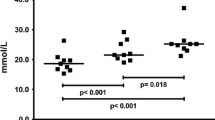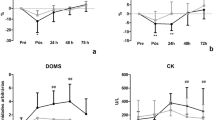Abstract
The principal objective of this paper is to develop a simple and rapid method of estimating levels of fatigue so that chronic fatigue can be prevented. Long-distance runners belonging to a successful corporate team (Group A; 25 males) and representative runners at the prefectural level (Group B; 14 males) participated in this study. We examined the effects of strenuous physical exercise on serum enzyme activity and the fatigue level felt by the runners (subjective fatigue).
The following parameters were measured on two consecutive mornings during a training period: physical characteristics, serum-biochemistry using the dry-chemistry method, and subjective fatigue determined using the questionnaire regarding subjective symptoms authorized by the Japan Association of Industrial Health and the Profile of Mood State (POMS). Group A was divided into A-Senior (17 males; highest performance level) and A-Freshman (8 males) subgroups according to the length of employment within the corporation (one year or more and less than one year, respectively).
The levels of serum aspartate aminotransferase (AST) and creatine kinase (CK) were significantly lower in the A-Senior group than the other groups and this group displayed the “iceberg” POMS profile at both examinations. Some significant correlations between the elements of POMS and serum enzyme activity levels were observed among all three groups during both examinations. The decline of serum CK levels tended to accompany a decrease in “Fatigue” according to POMS among 9 of 17 members of the A-Senior group. This tendency between the A-Senior and the A-Freshman groups statistically differed according to theX - square analysis.
Our results suggest that the effects of physical stress on serum enzyme activity levels and subjective fatigue are affected by performance levels. Physical fatigue seemed to be reflected by serum CK levels. Monitoring subjective fatigue while measuring serum enzyme activity levels using the dry-chemistry method immediately provides clinical value to players and coaches on site, and should therefore help to prevent a shift from “overreaching” to “overtraining”.
Similar content being viewed by others
References
Potempa KM. Chronic fatigue. Annu Rev Nurs Res 1993;11: 57–76.
Kawahara T. Prevention and policy against overtraining. J Clin Sports Med 1992;9: 489–95.
Sharp NCC, Koutedakis Y. Sport and the overtraining syndrome: Immunological aspects. British Medical Bulletin 1992;48: 518–33.
Budgett R. The overtraining syndrome. BMJ 1994;309: 465–8.
Lehmann M, Dickhuth HH, Gendrisch G, Lazar W, Thum M, Kaminski R, Aramendi JF, Peterke E, Wieland W, Keul J. Training-overtraining. A prospective, experimental study with experienced middle- and long-distance runners. Int J Sports Med 1991;12: 444–52.
Hooper SL, Mackinnon LT. Monitoring overtraining in athletes. Recommendations. Sports Med 1995;20: 321–7.
Bompa TO. Theory and Methodology of Training. Dubuque, Iowa: Kendall/Hunt Publishing Company, 1983.
Kuipers H, Keizer HA. Overtraining in elite athletes: review and directions for the future. Sports Med 1988;6: 79–92.
Falsetti HL. Overtraining in athletes - a round table. Physician and Sportsmedicine 1983;11: 93–110.
Fry RW, Morton AR, Keast D. Overtraining in athletes: An update. Sports Med 1991;12: 32–65.
Ferry A, Picard F, Duvallet A, Weill B, Rieu M. Changes in blood leucocyte populations induced by acute maximal and chronic submaximal exercise. Eur J Appl Physiol 1990;59: 435–42.
Benoni G, Bellavite P, Adami A, Chirumbolo S, Lippi G, Brocco G, Giulini GM, Cuzzolin L. Changes in several neutrophil functions in basketball players before, during and after the sports season. Int J Sports Med 1995;16: 34–7.
Pyne DB, Baker MS, Fricker PA, McDonald WA, Telford RD, Weidemann MJ. Effects of an intensive 12-wk training program by elite swimmers on neutrophil oxidative activity. Med Sci Sports Exerc 1995;27: 536–42.
Ndon J, Snyder AC, Foster C, Wehrenberg WB. Effects of chronic intense exercise training on the leukocyte response to acute exercise. Int J Sports Med 1992;13: 176–82.
Kogi K, Saito Y, Mitsuhashi T. Validity of three components of subjective fatigue feelings. J Science Labour 1970;46: 251–70.
McNair DM, Lorr M, Droppleman LF. Profile of Mood States Manual. San Diego: Educational and Industrial Testing Service. 1971.
Yamamoto K. POMS as an index of overtraining. J Clin Sports Med 1990;7: 561–5.
Frazier SE. A comparison of team mood state profiles utilizing the mental health model. J Human Movement Studies 1989;16: 91–9.
Kurimori S, Oka T, Kakizaki T. Evaluation of mental stress and fatigue induced by performance of a mental task. 2. An experiment in 11-h self-paced calculating task. Jpn J Ind Health 1994;36: 9–15.
Fry RW, Grove JR, Morton AR, Zeroni PM, Gaudieri S, Keast D. Psychological and immunological correlates of acute overtraining. Br J Sports Med 1994;28: 241–6.
Yamasaki K, Arakawa H, Suzukawa K, Ishizaki K, Kumae T. Comparisons between estimated body fat ratios using bioelectrical impedance analysis and skinfold thickness methods in long distance runners. J Phys Fit Nutr Immunol 1995;5: 109–17.
Okuda K, Naka K. Clinical Chemistry Analyzers for Stat Tests. Bunseki 1988: 54 – 9.
Kumae T, Arakawa H, Suzukawa K, Ishizaki K, Uchiyama I. A study on serum enzyme activity levels and subjective fatigue scores in university ekiden runners. Jpn J Phys Fitness Sports Med 1997;46: 189–200.
Kanai I. Manual of Clinical Laboratory Methods. In: Kanai M, editor. Tokyo: Kanehara Shuppan Co Ltd., 1994.
Japan Society of Clinical Chemistry. Recommended method for measurement of enzyme in human serum. Jpn J Clin Chem 1989;18: 211–25.
Vejjajiva A, Teasdale GM. Serum creatine kinase and physical exercise. Br Med J 1965;1: 1653–4.
Noakes TD. Effect of exercise on serum enzyme activities in humans. Sports Med 1987;4: 245–67.
Kumae T, Kawahara T, Uchiyama I. A study for prevention of chronic fatigue. Part 1. Effects of endurance running during one month on blood properties and subjective fatigue. Environ Health Prev Med 1997;2: 21–7.
Flynn MG, Pizza FX, Boone Jr JB, Andres FF, Michaud TA, Rodriguez-Zayas JR. Indices of training stress during competitive running and swimming seasons. Int J Sports Med 1994;15: 21–6.
Cannon JG, Orencole SF, Fielding RA, Meydani M, Meydani SN, Fiatarone MA, Blumberg JB, Evans WJ. Acute phase response in exercise: interaction of age and vitamin E on neutrophils and muscle enzyme release. Am J Physiol 1990;259: R1214–9.
Koutedakis Y, Raafat A, Sharp NCC, Rosmarin MN, Beard MJ, Robbins SW. Serum enzyme activities in individuals with different levels of physical fitness. J Sports Med Phys Fitness 1993;33: 252–7.
MacNeil B, Hoffman-Goetz L, Kendall A, Houston M, Arumugam Y. Lymphocyte proliferation responses after exercise in men: fitness, intensity, and duration effects. J Appl Physiol 1991;70: 179–85.
Nosaka K, Clarkson PM. Muscle damage following repeated bouts of high force eccentric exercise. Med Sci Sports Exerc 1995;27: 1263–9.
Verde T, Thomas S, Shepaed R. Potential markers of heavy training in highly trained distance runners. Br J Sports Med 1992;26: 167–75.
Morgan WP. Selected Psychological Factors Limiting Performance: a Mental Health Model. In:Clarke DH. Eckert HM. editors. Limits of human performance. Champaign, Illinois: Human Kinetics, 1985.
Zaichkowsky LD, Fuchs CZ. Biofeedback applications in exercise and athletic performance. Exerc Sport Sci Rev 1988;16: 381–421.
Morgan WP. The mind of the marathoner. Psychology Today 1978;11: 38–49.
Hooper SL, Mackinnon LT, Howard A, Gordon RD, Bachmann AW. Markers for monitoring overtraining and recovery. Med Sci Sports Exerc 1995;27: 106–12.
Morgan WP, Brown DR, Raglin JS, O’Connor PJ, Ellickson KA. Psychological monitoring of overtraining and staleness. Brit J Sports Med 1987;21: 107–14.
Hooper SL, Mackinnon LT, Wilson B. Biomechanical responses of elite swimmers to staleness and recovery. Aust J Sci Med Sport 1995;27: 9–13
Cannon JG. Exercise and resistance to infection. J Appl Physiol 1993;74: 973–81.
Author information
Authors and Affiliations
Rights and permissions
About this article
Cite this article
Kumae, T., Kurakake, S., Arakawa, H. et al. A study for prevention of chronic fatigue. part 2. effects of strenuous physical exercise performed in a training camp on serum enzyme activity levels and subjective fatigue.. Environ Health Prev Med 3, 89–95 (1998). https://doi.org/10.1007/BF02931790
Received:
Accepted:
Issue Date:
DOI: https://doi.org/10.1007/BF02931790




